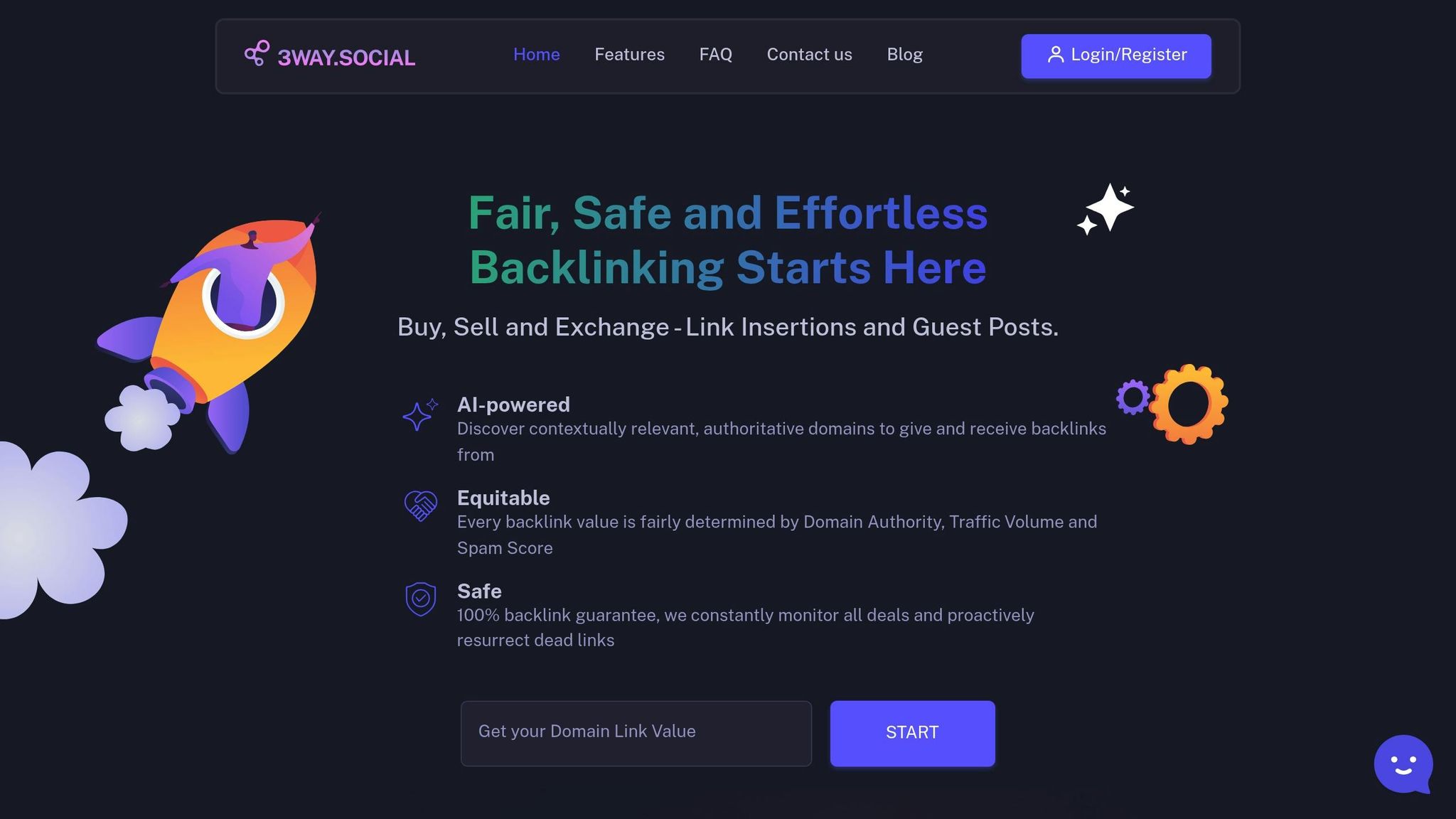Last Updated on July 21, 2025 by Becky Halls
Niche backlinks help your website rank better by connecting it with other sites in the same industry. These links signal search engines that your content is relevant and trustworthy. Combined with a strong domain authority (DA), this can improve your search rankings and attract the right audience.
Here’s why niche backlinks matter:
- Relevance is key: Links from industry-related sites carry more weight than general ones.
- Improves domain authority: DA predicts your site’s ranking potential (scored 1–100). Higher DA = better competition for top spots.
- Drives quality traffic: Niche backlinks bring visitors interested in your content or products.
To build niche backlinks:
- Identify relevant sites using tools like Ahrefs or SEMrush.
- Reach out with personalized emails offering guest posts, fixing broken links, or other value.
- Use platforms like 3Way.Social for automated, AI-powered link-building.
Focus on quality over quantity, monitor your link profile regularly, and track metrics like organic traffic, referring domains, and DA growth for long-term success.
7 Best Practices to Build Niche-Relevant Backlinks [2024]
How Relevance Affects Backlink Power
When it comes to backlinks, relevance is king. Google’s algorithms have evolved to prioritize contextual relevance over sheer quantity. This means the connection between the linking site and your content matters far more than just the number of links pointing to your site. For instance, a backlink from a respected health website to a fitness brand carries far more weight than one from a general news site. Why? Because relevant links act as endorsements from experts in your field, signaling to Google that your content is trustworthy and authoritative.
A steady stream of niche-relevant backlinks sends a clear message: your site is a reliable resource in your area of expertise. This “contextual boost” amplifies your SEO efforts, making it easier to rank for the terms that matter most to your business.
Building Authority in Your Industry
Establishing authority in your industry isn’t just about gaining visibility – it’s about being recognized as a credible source. Niche backlinks are instrumental in achieving this. These links not only improve your search rankings but also attract the type of visitors who are genuinely interested in your content or offerings.
Take, for example, a SaaS company that shifted its link-building strategy to focus on industry-specific blogs. The result? A 38% increase in organic traffic and better rankings for niche keywords. Similarly, a wellness blog saw a 120% surge in traffic within six months by combining guest posts on health-focused sites with links from high-profile news outlets. These examples show how targeting the right audience with relevant backlinks can directly impact your growth.
Niche vs General Backlinks Comparison
To understand why niche backlinks outperform general ones, let’s break down their differences:
| Feature | Niche-Relevant Backlinks | General Backlinks |
|---|---|---|
| Relevance | Strong alignment with your content | Weak or moderate alignment |
| Traffic Quality | Attracts engaged, targeted visitors | Broad, less-focused audience |
| Conversion Potential | Higher chance of engagement | Moderate likelihood of conversions |
| Domain Authority Impact | Builds expertise in specific areas | Strengthens overall authority |
| SEO Impact | Boosts rankings for niche keywords | Improves general domain strength |
Niche backlinks hold their value over time because they remain relevant to your industry. For instance, a link from a respected trade publication continues to benefit your site as long as both parties stay focused on the same subject. In contrast, general backlinks might lose their relevance as the linking site’s focus shifts. Plus, niche backlinks are less likely to raise red flags with Google’s algorithms, as they represent natural, logical connections between related content.
That said, general backlinks still play a role. They can enhance your site’s overall authority and introduce your content to broader audiences. The most effective strategy? A mix of both. Use niche backlinks to establish your expertise and rank for industry-specific terms, while leveraging general backlinks from high-authority sites to expand your reach. Together, they create a balanced approach that strengthens both relevance and visibility, setting the stage for actionable ways to secure niche backlinks.
How to Find and Get Niche Backlinks
Building niche backlinks takes a focused approach, combining research, strategy, and outreach. Here’s a step-by-step guide to help you secure links that matter.
Know Your Niche and Target Audience
To attract the right backlinks, you need a deep understanding of your niche and the audience you’re targeting. This means identifying the key players, influential sites, and topics that resonate with your audience.
Start by analyzing your competitors’ backlink profiles using tools like Ahrefs or SEMrush. These platforms can reveal where your competitors are getting their links, giving you ideas for potential opportunities. For instance, if you’re in real estate and notice competitors have backlinks from moving companies, you could create your own list of moving companies in your area to reach out to.
Another great feature in Ahrefs is the Competing Domains tool. By entering a competitor’s website, you’ll see a list of similar domains that cater to your audience, helping you uncover prospects you might not have considered.
If you’re targeting local audiences, Google Maps is a goldmine. For example, a fitness website looking to connect with gyms in Los Angeles can use Google Maps to build a list of local gyms. This method works especially well for businesses with a regional focus or a specific type of facility in mind.
Don’t overlook industry directories either. These can help you discover websites relevant to your niche. For example, a yoga studio might search for yoga blogs or health-related directories, while a SaaS company could explore directories like G2.com for link-building opportunities.
Once you’ve built your target list, take a moment to review your existing backlink profile.
Review and Fix Your Backlink Profile
Before chasing new backlinks, it’s smart to clean up and optimize the ones you already have. Use tools like Ahrefs, Moz, or SEMrush to analyze your current backlinks and assess their quality.
Focus on the context of your links. Links embedded naturally within high-quality content hold more weight than those stuck in sidebars or footers. Also, check if the linking sites align with your audience – this overlap can indicate what’s already working well.
Regular monitoring is key. Disavow harmful or low-quality links that could hurt your site’s credibility. A strong backlink profile should show steady, organic growth and a healthy mix of follow and nofollow links.
Lastly, evaluate your anchor text diversity. Ensure it’s varied and relevant, reflecting natural language rather than over-optimized keywords. If you notice gaps, adjust the anchor text to better align with your target keywords.
Once your existing profile is in good shape, it’s time to focus on outreach.
Outreach and Building Relationships
Successful outreach is all about building genuine connections. As Aleisha White from Brafton puts it:
“the outreach process must begin with identifying what truly matters to your outreach targets”.
Start by engaging on social media. Before sending a cold email, interact with your prospects by commenting on their posts or sharing their content. This builds familiarity and increases the chances of a positive response.
To find outreach opportunities, use Google search operators. Combine keywords with commands like inurl:, intitle:, or site: to locate pages like “write for us,” “guest post,” or “resources”.
When reaching out, offer value first. Instead of just asking for a backlink, provide something useful – like high-quality content, fixing broken links, or other assistance. With 66% of links on the web being broken, offering to repair broken links can be a great way to start a relationship.
Personalize your outreach emails. Use the recipient’s name, reference their content, and clearly explain what you’re offering within the first two sentences. A work email address adds credibility, and don’t hesitate to follow up once or twice if you don’t hear back.
Finally, consider using HARO (Help a Reporter Out). By responding to journalist queries, you can earn editorial backlinks from reputable sources.
With a clean backlink profile and a solid outreach plan, you’re well on your way to acquiring high-quality niche backlinks.
Using Tools and Platforms for Niche Link Building
While manual outreach and relationship-building are important, AI-powered tools and platforms can speed up the niche link-building process. These tools help automate tasks like finding link opportunities and building backlinks. By leveraging data, they analyze target audiences and personalize outreach messages, making the entire process more efficient and precise.
One of the biggest strengths of AI in link building is its ability to grasp context. AI algorithms can evaluate the relevance between keywords and potential domains, ensuring you focus on the most suitable websites. This saves you from wasting time on links that won’t help boost your domain authority. By prioritizing context and relevance, AI tools help you make smarter, more impactful decisions.
When selecting an AI-powered platform, opt for one that can distinguish between high-quality and poor-quality links. The best tools don’t just generate backlink opportunities – they identify websites that are both industry-specific and aligned with your niche audience.
How 3Way.Social Simplifies Niche Link Building

AI tools not only make link building faster but also directly contribute to improving your domain authority. 3Way.Social is a platform designed to simplify niche link building with its AI-powered domain matching system. Instead of spending countless hours searching for potential partners, the platform identifies relevant websites in your niche automatically.
One standout feature of 3Way.Social is its equitable link value system. This ensures fair exchanges based on factors like domain authority, traffic, and niche relevance, eliminating the guesswork from traditional link-building methods. Additionally, the platform guarantees permanent do-follow links. Unlike many exchanges where links might disappear or turn into nofollow, 3Way.Social monitors your backlinks and alerts you to any changes, protecting your investments.
The platform also offers guest posting opportunities within its vetted network, helping diversify your backlink profile. This includes varied page types, anchor text, and content placements, all of which contribute to a healthier, more robust backlink strategy.
Managing your campaigns is straightforward thanks to a user-friendly dashboard. You can track your link-building progress, monitor domain authority improvements, and manage multiple campaigns at once. The ability to categorize links and track efforts across different niches or projects makes it an efficient tool for businesses of all sizes.
Benefits of a Trusted SEO Network
Collaborating within a vetted network of SEO professionals reduces many of the risks tied to traditional link building. With 3Way.Social, you gain access to a carefully filtered network, avoiding spammy or low-quality sites that could harm your domain authority.
The platform also includes features like secure payment integration and accountability measures, adding a layer of trust to your link exchanges. Connecting with verified SEO professionals who understand the importance of high-quality links makes relationship management much easier. As Becky Halls, Co-Founder of PageTest.ai puts it:
“The tool automates the entire outreach process”.
This automation doesn’t stop at finding link opportunities. It extends to personalizing outreach emails, which can lead to higher response rates. The platform also categorizes websites by industry, streamlining your link-building efforts.
Being part of a trusted network offers ongoing support and monitoring. Unlike one-time link purchases, this approach ensures you have recourse if links are removed or altered. For example, the platform alerts you if a link is converted to nofollow or removed entirely, helping you maintain a strong backlink profile over time.
For businesses aiming to grow their domain authority through niche backlinks, 3Way.Social provides a scalable solution. It combines the efficiency of AI with the oversight of human expertise, delivering faster link acquisition, better quality control, and more reliable results. This blend of technology and strategy ensures your niche backlink efforts truly make an impact.
Measuring How Niche Backlinks Improve Domain Authority
Building niche backlinks from websites relevant to your industry is a strong start, but the real work begins when you measure how those links impact your domain authority (DA). Tracking and analyzing these changes is key to understanding the effectiveness of your strategy.
Tracking Domain Authority Growth
Domain Authority is scored on a scale from 1 to 100, where improvements are more noticeable at the lower end and become harder to achieve as your score climbs. Patience is important here – track your progress over time instead of expecting quick results.
Tools like Ahrefs, Moz, and SEMrush are excellent for monitoring your DA and analyzing your backlink profile. Begin by recording your starting DA and check monthly to identify trends. Comparing your score to other websites in your niche can also highlight areas where you might need to improve.
But DA alone doesn’t tell the whole story. To get a fuller picture, focus on additional metrics that gauge the broader impact of your backlink efforts.
Key Metrics to Watch
While Domain Authority is a helpful benchmark, a well-rounded measurement strategy includes tracking other important metrics:
- Referring domains: The number of unique websites linking to yours directly affects your DA. For growing sites, having over 100 referring domains is considered a healthy benchmark. Keep in mind, though, that quality trumps quantity – just a few backlinks from highly relevant, authoritative sites can outweigh dozens of low-quality links.
- Organic traffic growth: Organic traffic is a clear indicator of success. Track both search engine traffic and referral traffic from your backlinks. This will help you see how well your link-building strategy aligns with user engagement and conversions.
- Anchor text distribution: A natural mix of anchor text is crucial. Use a variety of anchor types – branded terms, exact match keywords, partial match phrases, and generic text – to avoid search engine penalties for over-optimization.
- Link placement and context: Not all backlinks are created equal. Links placed within the main content of a page carry more weight than those in footers or sidebars. Focus on securing editorial, in-content links for maximum impact.
- Backlink growth rate: Aim for a steady growth rate of 5–10% per month. Sudden spikes can look suspicious to search engines, while a slow growth rate might not generate enough momentum for meaningful results.
Running Regular Backlink Audits
Routine audits of your backlink profile are crucial for maintaining and improving your domain authority. These audits help you catch harmful links before they hurt your SEO performance. Plan for quarterly deep dives into your backlink profile, with monthly spot-checks to stay on top of any changes.
During audits, look for problematic links, such as those from spammy or irrelevant sites. Red flags include links from foreign-language websites unrelated to your niche, known link farms, or suspicious anchor text patterns. Technical issues also matter – watch for links that have switched from dofollow to nofollow, pages that now return 404 errors, or links from penalized or deindexed sites. Tools like Ahrefs and SEMrush can automate much of this work and alert you to changes in your backlinks.
If you identify harmful links, document them carefully. For links that can’t be removed manually, create a disavow file and use Google Search Console’s disavow tool cautiously – only for links that pose a real risk to your rankings. On the flip side, nurture positive link relationships. If a site removes your backlink, reach out to understand why. Keep an eye on your best-performing links to ensure they remain active and properly formatted. Building strong relationships with linking sites can prevent link removals and may even lead to new opportunities.
Regular audits also help uncover missed opportunities. For example, you might find competitor backlinks you can replicate or unlinked mentions of your brand that you can reclaim. These small wins can add up to big results over time.
The Power of Niche Backlinks
Niche backlinks stand out as one of the most effective tools in SEO, delivering precise, targeted results that general backlinks often can’t match. For example, a wellness blog saw its traffic surge by 120% in just six months by combining guest posts on health-focused sites with high-authority links from top-tier news outlets.
This highlights a key principle in link building: relevance beats quantity. Backlinks from sites within your specific industry help establish your website as a trusted authority, making it more likely for search engines to recommend your content.
Here’s why it works. Search engines prioritize topical clarity, and niche-relevant backlinks send strong signals about your expertise . These links help search engines better understand your site’s focus, ensuring it reaches the right audience. The result? Better rankings for competitive keywords and more qualified traffic – visitors who are more likely to convert.
Niche backlinks also offer a layer of protection against algorithmic penalties. Unlike general backlinks, they’re less likely to trigger Google’s spam filters because they emphasize relevance and credibility. This added contextual value gives niche backlinks a clear edge, often driving higher-quality leads compared to the broader reach of general backlinks .
That said, a well-rounded backlink profile is still important. While a mix of niche-relevant and general backlinks showcases your website’s diversity and authority, the core of your strategy should focus on quality, targeted links that reinforce your niche expertise . Building this strong foundation opens the door for advanced niche link-building strategies.
The real power of niche backlinks lies in their long-term benefits. By fostering industry relationships and creating valuable content that naturally attracts these links, you’re not just boosting your SEO today – you’re building sustainable authority for the future.
FAQs
How do niche-specific backlinks help improve my website’s domain authority?
Niche-specific backlinks are a powerful tool for increasing your website’s domain authority. These links come from websites that are directly related to your industry or topic, signaling to search engines that your site is not only relevant but also a trusted resource within your field.
What sets niche backlinks apart from general ones is their focused relevance. They strengthen your site’s credibility in a specific area, making it easier for search engines to grasp the value of your content. Over time, this can lead to higher rankings and a noticeable boost in domain authority.
How can I find and connect with websites for niche-specific backlinks?
To find and connect with backlink opportunities specific to your niche, start by using search operators like "[your niche] + write for us" to locate relevant websites. Another effective strategy is to analyze your competitors’ backlinks – this can reveal sites that have already linked to others in your industry, giving you a roadmap for outreach.
You can also tap into niche communities, forums, or industry directories to uncover potential partners. These spaces often host site owners or contributors who are open to collaboration.
Guest posting is another tried-and-true method. By contributing high-quality content to well-known websites in your niche, you can earn backlinks while building credibility. Tools like Ahrefs or SEMrush are particularly helpful for identifying authoritative websites that align with your goals. Building genuine relationships with site owners and offering them valuable, tailored content can significantly improve your chances of landing those all-important backlinks.
How can I measure the impact of niche backlinks on my website’s SEO performance over time?
To understand how niche backlinks influence your website’s SEO, keep an eye on important metrics like keyword rankings, domain authority, and organic traffic over time. Tools like Ahrefs, SEMrush, or Google Analytics can help you track these changes and spot trends.
It’s also important to evaluate the quality of your backlinks. Look at factors like their relevance to your niche, the authority of the linking sites, and the variety of sources. Comparing niche-specific backlinks with more general ones can reveal which type performs better for your goals. Make it a habit to review these metrics regularly to ensure your link-building efforts are delivering noticeable results.



